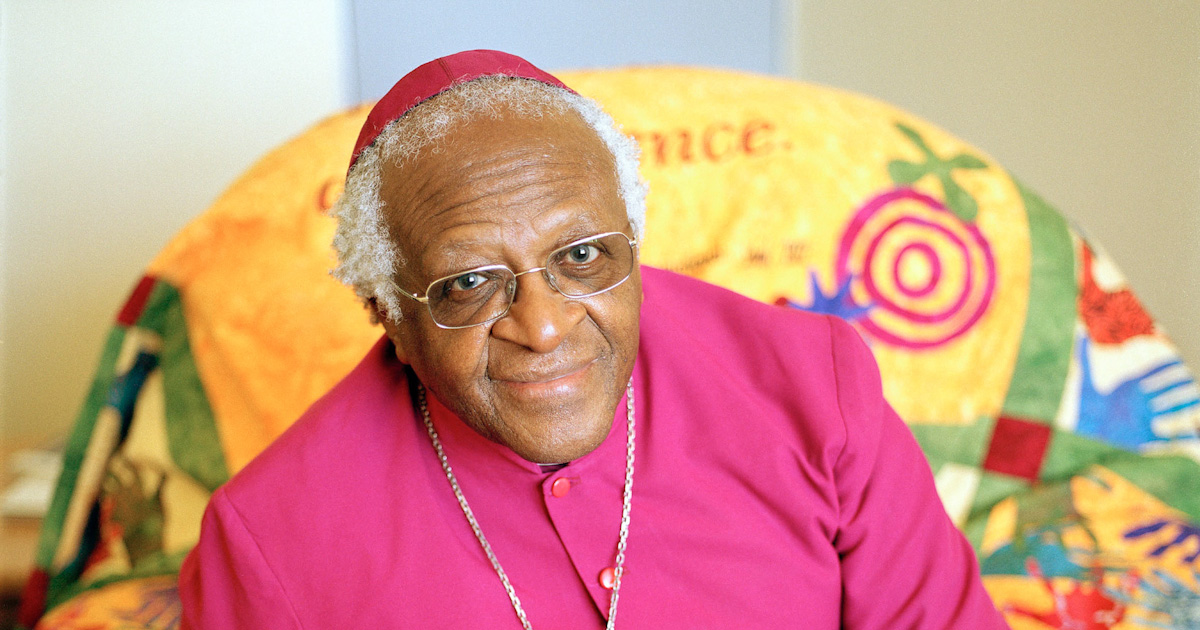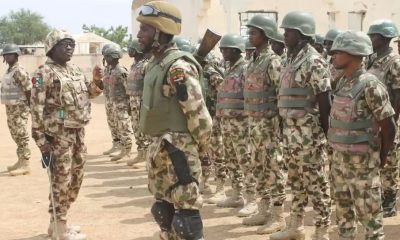Comments and Issues
Contrast and convergence in Nation building: A post-mortem on apartheid and the lives of Frederik Willem De Klerk and Desmond Tutu
Published
2 years agoon
By
Publisher
By Godknows Igali, PhD
It was the Ancient Egyptians that entitled one of their intriguing literature “Book of the Dead”, adumbrating with rather awry poignancy, and the inevitable duel of humanity with mortality. Death visited its pangs on the nation of South Africa and the African continent as a whole as, Frederick William de Klerk, (1936-2021) who had once ruled the country for six years and ace activist clergyman, Arch Bishop Desmond Tutu (1931-2021) got enlisted in its books. Both men, attained the ripe ages of 85 years and 90 years, respectfully. Strikingly, their accomplished lives were replete of sharp parallels, opposites and ultimately unisons. Not just their country, with the self-styled sobriquet of “Rainbow Nation” a metaphor for its complexion of racial mix mourned them but the global reminiscences of their lives were spontaneous and high pitched.
TWO MEN, TWO CONVICTIONS AND TWO VOCATIONS
Strong in desperate convictions, the duo were also avowed foes, antagonists and each other’s group nemesis for a reasonable share of their adult lives; not deliberately self-willed but wrested on them by fate. On one hand, Klerk is descent of the ruling political class of ultra conservative white settlers. He was of the fiercest band of minority White supremacism, and purveyors of Apartheid political credo. Aside, Tutu was not only one of the most vocal voices on global morality, but as a Blackman, amongst the most dogged combatants against Apartheid and White Minority Rule.
Also read: FG succumbs, shelves fuel subsidy removal’s plan
Though a trained lawyer from Potchefstroom University, South Africa he was nurtured in the crudest form of racial discrimination and the oppressive expressions that came with it. Like a masquerade expected to dance to rhythms long written before, so his was to enforce what his community of European common descent, ashored high and dry in the belly of equatorial Africa wanted him to do. The fight for survival, for him and his kindred was legitimated fiercely by historical realism and narrow ranged instincts of self-preservation. In a hostile way, he joined to enforce the existing devilry from the early 1970s when he began to hold high public offices. He later became Minister of Social Welfare and Pensions, Minister of Posts and Telecommunications and later, Minister of Mines. However, his most notorious assignments were, respectively Minister of Interior and Minister of Education. Eventually he became President in 1989. Later, he was humble enough to revert to the position of Deputy President under the first Black President of the country from 1994 to 1996.
Also read: APC convention: Tinubu, others kick against Buhari’s consensus arrangement
His partner in life’s fight and death, Archbishop Tutu was a man of collar and theology. He had a Bachelors of Arts degree from the University of South Africa, which today is the largest University in Africa, with 420,000 students. In 1960, he chose priesthood, becoming formally ordained the following year and therefore proceeding to Kings College, London for further theological training. He steadily rose through various positions in the Anglican Church in South Africa, Lesotho, and the African Council of Churches. He ultimately held the highest ecclesiastical office as Archbishop of Cape Town and Head of the Church of South Africa.
What made Tutu particularly outstanding was, the fact, that from his earliest priestly days, he stood out as a bellwether of moral rectitude, fight against injustice, unfairness and abuse of human rights not only in his country but the world over. Like the defiant German monk, Dr Martin Luther (1483-1546), about 460 years and the liberation theologises of Latin America, he was loud, defiant and unbending. His treatise was simple. Apartheid was not just injurious to man and human conscience but was a rude disregard for natural order and God’s ordinances. Gladly, unlike the political class, his audience was boundless globally.
Also read: Political and economic quagmire and the girl-child bizarre experience in South Sudan
EXPLAINING THE “WHITES” IN SOUTH AFRICA
Like the human metabolic system, the process of fission, fusion and diffusion of populations has been an important part of human history. Some cases such as the strong black presence in the Americas and Europe, a product of the much loathed Transatlantic Slave Trade, is more known. Related but rather insidious, was the Arab Conquest and demographic reconfiguration of North Africa, nearly 2,000 years ago. In the latter case, time and shared acculturation have helped attenuate to barest minimum the state of inter group disharmony and friction.
The situation of some other regions such as Australia and New Zealand, is peculiar, and akin to the Dutch movement into South Africa.
Going back to the vision of Prince Henry, the Navigator (1394-1460), the Portuguese where the first Europeans to arrive South Africa from the 1488. They named the entire Southern Africa, “Cape of Good Hope”, foretelling their desired move into Asia (India, in particular). To aid the ingress and egress of their ships then berthing at what is known today as Cape Town, the Dutch who arrived about the time, became the first Europeans to establish a colony on sub Saharan African soil in 1652. Gladly, the existence of temperate seasonal weather, as it is in Europe, added with the relative absence of mosquitoes favoured quick and rapid population shifts. Much later. The British equally came in to the area, both as bounty from intra-European wars and actual conquest over the Dutch in what became known as the Anglo-Boer Wars. Hence they became the dominant colonial power from 1807. In 1820, the British authorities persuaded about 5,000 middle-class British immigrants to leave Great Britain and also move into the area. As the area attracted a surge in the number of Dutch, a good number of them started to penetrate more inland subduing with varying degrees of success by mortar and ashes, the indigenous people, viz, Xhosa, Bapedi, Tswana, South Ndebele, Basotho, Venda, Tsonga and Swazi.
In course of time, all these alien groups in a criss-cross of what became known as “trekking” consolidated their presence in the interior and established – Cape colony, Natal Colony, Orange-Free Colony and Transvaal Colony forming. Ultimately, the Dutch developed their unique language- Afrikaans and a peculiar form of group consciousness. The Boers or Afrikaners as the Dutch became known and even British also moved quickly to appropriate over 70% of the arable land of the country even though there population never increased beyond 20%. At the same time, natural resources of the mineral-rich country, one of the world’s highest deposits in gold and diamond became exclusively for the Dutch or British. Such European companies as De Beers Consolidated Mines and its founder, John Cecil became the owners of the country’s mines while the Blacks overtime, becoming the “hewers of wood”,
Tracing Apartheid internal politics started the internecine conflict between the Dutch (Boers or Afrikaners) and the British came to an end in 1902 when the former surrendered. In the 1910, what became known as the Union of South Africa, which was a self-Governing Dominion within the British Empire became a nation, propelling an increase in the momentum of political activities in the country. To ensure their group dominance, a political system that promoted Racial Segregation began to be enforced. This was similar to America’s segregationist Jim Crow Laws, of the 1860s. Politics at that time became, predominantly, for the white settlers among themselves, even as series of laws were promulgated from 1913-1936, restricting the black owners of the land to “tribal areas”.
The British actually pioneered what they called Unionist Party (South Africa) in May 1910 though this quickly dissolved in 1920, when it merged into what became known as South African Party. The Boers also formed their political party known as the National Party of South Africa, in 1910 being a far right wing organization for the preservation of their identity. This notwithstanding in 1912, the few educated Blacks from the country who hitherto had been known under South African Native National Congress founded a political party – South African Congress – which later became known as African National Congress (ANC). Eventually, the country became a sovereign nation and member of the Commonwealth of Nations in 1934 and on 31st May 1961 became a Republic.
To the exclusion of the indigenous populations, the Boers dominated the governance of the country for much of its early history under the South African Party. Things took a turn for the worse in 1948 when the National Party of the Boers took over full governance of the country unleashing resentment on other groups was at two levels. First but less vicious was against the British who were minorities compared to them but figuratively ruled the country for many years as part of the British Empire. More profound to this was their discrimination against the Blacks who they considered as inferior. Indeed, prior to their full political ascendency, a secret Fraternity known as the Afrikaner Broderbund (Afrikaner Brotherhood), had been formed to perpetrate Dutch influence and control. It was based on this ideological thrust by this organization that the policy of “Apartheid”, meaning separateness was introduced as the National Party that took over in 1948. Apartheid perpetrated the oppressive rule over the Blacks in South Africa producing some of the most vicious human beings that human history ever saw.
Apartheid which Klerk inherited was therefore formatted to fight, dominate and repress the wrongly perceived enemies. Forgetting the well-studied and scientific evidence of the biological commonality of humankind irrespective of race, creed or tongue, Apartheid insisted on creating its own narrow worldview that separated people based on the physical pigmentation. Whites, as superior castes, in between came Coloured (racially mixed persons and Asiatics) and Blacks as the underdogs. It was a kind of one country, several legal, jurisprudential and social systems.
Amongst other things Apartheid denied non-whites the right to vote, intensified segregation, and disallowed inter racial marriages and sexual relationships and placed severe rights of movement. Brutality against blacks, repression and torture became the order of the day. In the face of global opposition, the Apartheid system also created what it called Bantustans for Blacks to enable them live in their tribal enclaves.
FIGHT AGAINST APARTHEID
Expectedly, Apartheid was strongly opposed not just by the ANC, the dominant black group, but by almost all other bodies such as Labour Unions, Pan African Congress (PAC) which was a break away from the ANC, the Communist Party of South Africa founded in 1921, South African Indian Congress formed in 1921, South African Congress of Democrats formed in 1952. Much later came the wholly back and groups as the Inkatha Freedom Party (IFP). Apartheid was also strongly opposed by the rest of the world especially the broad coalition known as Anti-Apartheid Movement founded in 1959 by British clergyman, Trevor Huddleston.
From the 1950s, following the rise of a new generation of Black leaders such as Nelson Mandela, Winnie Mandela, Oliver Tambo, Walter Sisulu, Govan Mbeki, Raymond Mblaba, there was an aggressive move to embark on Defiance Campaigns. Indeed, by 1955, Mandela and his team launched a Freedom Charter stating the objectives of the struggle for emancipation of the blacks. Although, both ANC and PAC had all hitherto insisted on peaceful protest, this became no longer tenable with increasing repression, and a form of armed struggle started to be canvassed as inevitable. Accordingly, a militant wing of the ANC known as “Umkhonto we Sizwe” (Speer of the Nation) was established in 1963.
Increasingly Black leaders who were politically active and opposed the system were hauled into horrendous maximum prisons for decades. Some others like Steve Biko who was a veteran student union leader and Joe Slovo from the Communist Party were easily murdered. In other more audacious instances such as the Sharpeville Massacre of 21st of March 1960 and Soweto massacre of 16th June 1976, hundreds of unarmed Black Youths were murdered during “Defiance Campaigns”.
These notwithstanding, the 1970’s and the 80’s saw an upsurge in guerrilla attacks on white dominated institutions, coming hand in hand with unscaled international pressure for reform and change. Indeed, the Anti-Apartheid theme began to dominate discussions at United Nations and other international fora for all manner of sanctions were also imposed on the separatist South African government. These all heralded the capitulation of obnoxious system from the 1980s.
First was the constitutional reforms of 1983 to allow Coloured and Indian limited participation in separate Legislative Houses which were established. This led on 24th July 1986 also to the abolition of the “Pass Laws”, which since 1952 restricted the movement of certain citizens particularly the blacks into most urban parts of the country. It was during this period, that the burden of governance fell on de Klerk as leader of National Party and Head of Government to open formal negotiations with the blacks led by ANC. Eventually, this paved the way for the release of Mandela and other political prisoners, after a quarter of a century in incarceration. It also ensured the reconfiguration of the country into nine (9) new provinces to replace the four (4) provinces for whites and ten (10) black homelands. In the eventual elections held in April 1994, the ANC led by Mandela won with over 62% leading to the swearing in of the country’s First Black President.
A WORTHY SHARED LEGACY
For the fact that Klerk lived and rose through the ranks of the oppressive Apartheid system, some groups especially in South Africa, are averse to his seeming spiritual and mortal rebirth later in life and the bold steps which he took to dismantle what seemed like his group’s inheritance. It must be appreciated however, that despite the daunting challenge of his own white extremist groups to disrupt the process of political reform, when it started, he was able to insist that Apartheid had to be pulled down. Beyond that, during the transition period, and even after leaving power, he has openly apologized for the atrocities committed by the group which he hitherto belonged to who perpetuated one of the most heinous crimes ever committed by man against man.
Indeed at the dawn of the new nation, Bishop Tutu provided the moral and spiritual forte for Black sustenance in negotiation and building an inclusive new nation. Thereafter, he was trusted with one of the most difficult assignments for any black man in that country. After his life-long combat against Apartheid, after using his position as a leading clergy global Christian communion to tour the world to pour out invectives on separatist leaders, the onus now fell on him to head what the country called “Truth and Reconciliation Committee”. Indeed, they needed a man of candour with the grace of God to help reconcile the irreconcilables. This he did with the highest level of dexterity.
In death, de Klerk shared a place of heroism with Bishop Tutu as they both settled to build a country where the painful years had to be seen from the prism of “no winner no vanquished”.
As the curtain of life eclipsed on these two global figures, the Nobel Peace Prize, which they won respectively in 1984 for Tutu and 1993 for de Klerk, would dwarf in the face of their eternal appreciation and applause as men of incontrovertible legacies and strength of character.
Igali is Pro Chancellor, Federal University of Technology, Akure (FUTA)CONTRAST AND CONVERGENCE IN NATION BUILDING: A POST MORTEM ON APARTHEID AND THE LIVES OF FREDERIK WILLEM DE KLERK AND DESMOND TUTU
Godknows Igali, PhD
It was the Ancient Egyptians that entitled one of their intriguing literature “Book of the Dead”, adumbrating with rather awry poignancy, and the inevitable duel of humanity with mortality. Death visited its pangs on the nation of South Africa and the African continent as a whole as, Frederick William de Klerk, (1936-2021) who had once ruled the country for six years and ace activist clergyman, Arch Bishop Desmond Tutu (1931-2021) got enlisted in its books. Both men, attained the ripe ages of 85 years and 90 years, respectfully. Strikingly, their accomplished lives were replete of sharp parallels, opposites and ultimately unisons. Not just their country, with the self-styled sobriquet of “Rainbow Nation” a metaphor for its complexion of racial mix mourned them but the global reminiscences of their lives were spontaneous and high pitched.
TWO MEN, TWO CONVICTIONS AND TWO VOCATIONS
Strong in desperate convictions, the duo were also avowed foes, antagonists and each other’s group nemesis for a reasonable share of their adult lives; not deliberately self-willed but wrested on them by fate. On one hand, Klerk is descent of the ruling political class of ultra conservative white settlers. He was of the fiercest band of minority White supremacism, and purveyors of Apartheid political credo. Aside, Tutu was not only one of the most vocal voices on global morality, but as a Blackman, amongst the most dogged combatants against Apartheid and White Minority Rule.
Though a trained lawyer from Potchefstroom University, South Africa he was nurtured in the crudest form of racial discrimination and the oppressive expressions that came with it. Like a masquerade expected to dance to rhythms long written before, so his was to enforce what his community of European common descent, ashored high and dry in the belly of equatorial Africa wanted him to do. The fight for survival, for him and his kindred was legitimated fiercely by historical realism and narrow ranged instincts of self-preservation. In a hostile way, he joined to enforce the existing devilry from the early 1970s when he began to hold high public offices. He later became Minister of Social Welfare and Pensions, Minister of Posts and Telecommunications and later, Minister of Mines. However, his most notorious assignments were, respectively Minister of Interior and Minister of Education. Eventually he became President in 1989. Later, he was humble enough to revert to the position of Deputy President under the first Black President of the country from 1994 to 1996.
His partner in life’s fight and death, Archbishop Tutu was a man of collar and theology. He had a Bachelors of Arts degree from the University of South Africa, which today is the largest University in Africa, with 420,000 students. In 1960, he chose priesthood, becoming formally ordained the following year and therefore proceeding to Kings College, London for further theological training. He steadily rose through various positions in the Anglican Church in South Africa, Lesotho, and the African Council of Churches. He ultimately held the highest ecclesiastical office as Archbishop of Cape Town and Head of the Church of South Africa.
What made Tutu particularly outstanding was, the fact, that from his earliest priestly days, he stood out as a bellwether of moral rectitude, fight against injustice, unfairness and abuse of human rights not only in his country but the world over. Like the defiant German monk, Dr Martin Luther (1483-1546), about 460 years and the liberation theologises of Latin America, he was loud, defiant and unbending. His treatise was simple. Apartheid was not just injurious to man and human conscience but was a rude disregard for natural order and God’s ordinances. Gladly, unlike the political class, his audience was boundless globally.
EXPLAINING THE “WHITES” IN SOUTH AFRICA
Like the human metabolic system, the process of fission, fusion and diffusion of populations has been an important part of human history. Some cases such as the strong black presence in the Americas and Europe, a product of the much loathed Transatlantic Slave Trade, is more known. Related but rather insidious, was the Arab Conquest and demographic reconfiguration of North Africa, nearly 2,000 years ago. In the latter case, time and shared acculturation have helped attenuate to barest minimum the state of inter group disharmony and friction.
The situation of some other regions such as Australia and New Zealand, is peculiar, and akin to the Dutch movement into South Africa.
Going back to the vision of Prince Henry, the Navigator (1394-1460), the Portuguese where the first Europeans to arrive South Africa from the 1488. They named the entire Southern Africa, “Cape of Good Hope”, foretelling their desired move into Asia (India, in particular). To aid the ingress and egress of their ships then berthing at what is known today as Cape Town, the Dutch who arrived about the time, became the first Europeans to establish a colony on sub Saharan African soil in 1652. Gladly, the existence of temperate seasonal weather, as it is in Europe, added with the relative absence of mosquitoes favoured quick and rapid population shifts. Much later. The British equally came in to the area, both as bounty from intra-European wars and actual conquest over the Dutch in what became known as the Anglo-Boer Wars. Hence they became the dominant colonial power from 1807. In 1820, the British authorities persuaded about 5,000 middle-class British immigrants to leave Great Britain and also move into the area. As the area attracted a surge in the number of Dutch, a good number of them started to penetrate more inland subduing with varying degrees of success by mortar and ashes, the indigenous people, viz, Xhosa, Bapedi, Tswana, South Ndebele, Basotho, Venda, Tsonga and Swazi.
In course of time, all these alien groups in a criss-cross of what became known as “trekking” consolidated their presence in the interior and established – Cape colony, Natal Colony, Orange-Free Colony and Transvaal Colony forming. Ultimately, the Dutch developed their unique language- Afrikaans and a peculiar form of group consciousness. The Boers or Afrikaners as the Dutch became known and even British also moved quickly to appropriate over 70% of the arable land of the country even though there population never increased beyond 20%. At the same time, natural resources of the mineral-rich country, one of the world’s highest deposits in gold and diamond became exclusively for the Dutch or British. Such European companies as De Beers Consolidated Mines and its founder, John Cecil became the owners of the country’s mines while the Blacks overtime, becoming the “hewers of wood”,
Tracing Apartheid internal politics started the internecine conflict between the Dutch (Boers or Afrikaners) and the British came to an end in 1902 when the former surrendered. In the 1910, what became known as the Union of South Africa, which was a self-Governing Dominion within the British Empire became a nation, propelling an increase in the momentum of political activities in the country. To ensure their group dominance, a political system that promoted Racial Segregation began to be enforced. This was similar to America’s segregationist Jim Crow Laws, of the 1860s. Politics at that time became, predominantly, for the white settlers among themselves, even as series of laws were promulgated from 1913-1936, restricting the black owners of the land to “tribal areas”.
The British actually pioneered what they called Unionist Party (South Africa) in May 1910 though this quickly dissolved in 1920, when it merged into what became known as South African Party. The Boers also formed their political party known as the National Party of South Africa, in 1910 being a far right wing organization for the preservation of their identity. This notwithstanding in 1912, the few educated Blacks from the country who hitherto had been known under South African Native National Congress founded a political party – South African Congress – which later became known as African National Congress (ANC). Eventually, the country became a sovereign nation and member of the Commonwealth of Nations in 1934 and on 31st May 1961 became a Republic.
To the exclusion of the indigenous populations, the Boers dominated the governance of the country for much of its early history under the South African Party. Things took a turn for the worse in 1948 when the National Party of the Boers took over full governance of the country unleashing resentment on other groups was at two levels. First but less vicious was against the British who were minorities compared to them but figuratively ruled the country for many years as part of the British Empire. More profound to this was their discrimination against the Blacks who they considered as inferior. Indeed, prior to their full political ascendency, a secret Fraternity known as the Afrikaner Broderbund (Afrikaner Brotherhood), had been formed to perpetrate Dutch influence and control. It was based on this ideological thrust by this organization that the policy of “Apartheid”, meaning separateness was introduced as the National Party that took over in 1948. Apartheid perpetrated the oppressive rule over the Blacks in South Africa producing some of the most vicious human beings that human history ever saw.
Apartheid which Klerk inherited was therefore formatted to fight, dominate and repress the wrongly perceived enemies. Forgetting the well-studied and scientific evidence of the biological commonality of humankind irrespective of race, creed or tongue, Apartheid insisted on creating its own narrow worldview that separated people based on the physical pigmentation. Whites, as superior castes, in between came Coloured (racially mixed persons and Asiatics) and Blacks as the underdogs. It was a kind of one country, several legal, jurisprudential and social systems.
Amongst other things Apartheid denied non-whites the right to vote, intensified segregation, and disallowed inter racial marriages and sexual relationships and placed severe rights of movement. Brutality against blacks, repression and torture became the order of the day. In the face of global opposition, the Apartheid system also created what it called Bantustans for Blacks to enable them live in their tribal enclaves.
FIGHT AGAINST APARTHEID
Expectedly, Apartheid was strongly opposed not just by the ANC, the dominant black group, but by almost all other bodies such as Labour Unions, Pan African Congress (PAC) which was a break away from the ANC, the Communist Party of South Africa founded in 1921, South African Indian Congress formed in 1921, South African Congress of Democrats formed in 1952. Much later came the wholly back and groups as the Inkatha Freedom Party (IFP). Apartheid was also strongly opposed by the rest of the world especially the broad coalition known as Anti-Apartheid Movement founded in 1959 by British clergyman, Trevor Huddleston.
From the 1950s, following the rise of a new generation of Black leaders such as Nelson Mandela, Winnie Mandela, Oliver Tambo, Walter Sisulu, Govan Mbeki, Raymond Mblaba, there was an aggressive move to embark on Defiance Campaigns. Indeed, by 1955, Mandela and his team launched a Freedom Charter stating the objectives of the struggle for emancipation of the blacks. Although, both ANC and PAC had all hitherto insisted on peaceful protest, this became no longer tenable with increasing repression, and a form of armed struggle started to be canvassed as inevitable. Accordingly, a militant wing of the ANC known as “Umkhonto we Sizwe” (Speer of the Nation) was established in 1963.
Increasingly Black leaders who were politically active and opposed the system were hauled into horrendous maximum prisons for decades. Some others like Steve Biko who was a veteran student union leader and Joe Slovo from the Communist Party were easily murdered. In other more audacious instances such as the Sharpeville Massacre of 21st of March 1960 and Soweto massacre of 16th June 1976, hundreds of unarmed Black Youths were murdered during “Defiance Campaigns”.
These notwithstanding, the 1970’s and the 80’s saw an upsurge in guerrilla attacks on white dominated institutions, coming hand in hand with unscaled international pressure for reform and change. Indeed, the Anti-Apartheid theme began to dominate discussions at United Nations and other international fora for all manner of sanctions were also imposed on the separatist South African government. These all heralded the capitulation of obnoxious system from the 1980s.
First was the constitutional reforms of 1983 to allow Coloured and Indian limited participation in separate Legislative Houses which were established. This led on 24th July 1986 also to the abolition of the “Pass Laws”, which since 1952 restricted the movement of certain citizens particularly the blacks into most urban parts of the country. It was during this period, that the burden of governance fell on de Klerk as leader of National Party and Head of Government to open formal negotiations with the blacks led by ANC. Eventually, this paved the way for the release of Mandela and other political prisoners, after a quarter of a century in incarceration. It also ensured the reconfiguration of the country into nine (9) new provinces to replace the four (4) provinces for whites and ten (10) black homelands. In the eventual elections held in April 1994, the ANC led by Mandela won with over 62% leading to the swearing in of the country’s First Black President.
A WORTHY SHARED LEGACY
For the fact that Klerk lived and rose through the ranks of the oppressive Apartheid system, some groups especially in South Africa, are averse to his seeming spiritual and mortal rebirth later in life and the bold steps which he took to dismantle what seemed like his group’s inheritance. It must be appreciated however, that despite the daunting challenge of his own white extremist groups to disrupt the process of political reform, when it started, he was able to insist that Apartheid had to be pulled down. Beyond that, during the transition period, and even after leaving power, he has openly apologized for the atrocities committed by the group which he hitherto belonged to who perpetuated one of the most heinous crimes ever committed by man against man.
Indeed at the dawn of the new nation, Bishop Tutu provided the moral and spiritual forte for Black sustenance in negotiation and building an inclusive new nation. Thereafter, he was trusted with one of the most difficult assignments for any black man in that country. After his life-long combat against Apartheid, after using his position as a leading clergy global Christian communion to tour the world to pour out invectives on separatist leaders, the onus now fell on him to head what the country called “Truth and Reconciliation Committee”. Indeed, they needed a man of candour with the grace of God to help reconcile the irreconcilables. This he did with the highest level of dexterity.
In death, de Klerk shared a place of heroism with Bishop Tutu as they both settled to build a country where the painful years had to be seen from the prism of “no winner no vanquished”.
As the curtain of life eclipsed on these two global figures, the Nobel Peace Prize, which they won respectively in 1984 for Tutu and 1993 for de Klerk, would dwarf in the face of their eternal appreciation and applause as men of incontrovertible legacies and strength of character.
Igali is Pro Chancellor, Federal University of Technology, Akure (FUTA)
Trending

 Football1 day ago
Football1 day agoGuardiola advised to take further action against De Bruyne and Haaland after both players ‘abandoned’ crucial game

 Business1 week ago
Business1 week agoDollar crashes further against Naira at parallel market

 Business1 week ago
Business1 week agoRecapitalisation: Zenith Bank to raise funds in international capital market

 Education1 week ago
Education1 week agoArmy reveals date for COAS 2024 first quarter conference

 Crime1 week ago
Crime1 week agoFleeing driver injures two on Lagos-Badagry expressway

 Covid-191 week ago
Covid-191 week agoBritish legislator demands Bill Gates, other ‘COVID Cabal’ faces death penalty

 Latest5 days ago
Latest5 days agoIsrael pounds Hezbollah with airstrikes after Iran attack

 Business1 week ago
Business1 week agoZenith Bank surpasses N2trn earnings milestone


